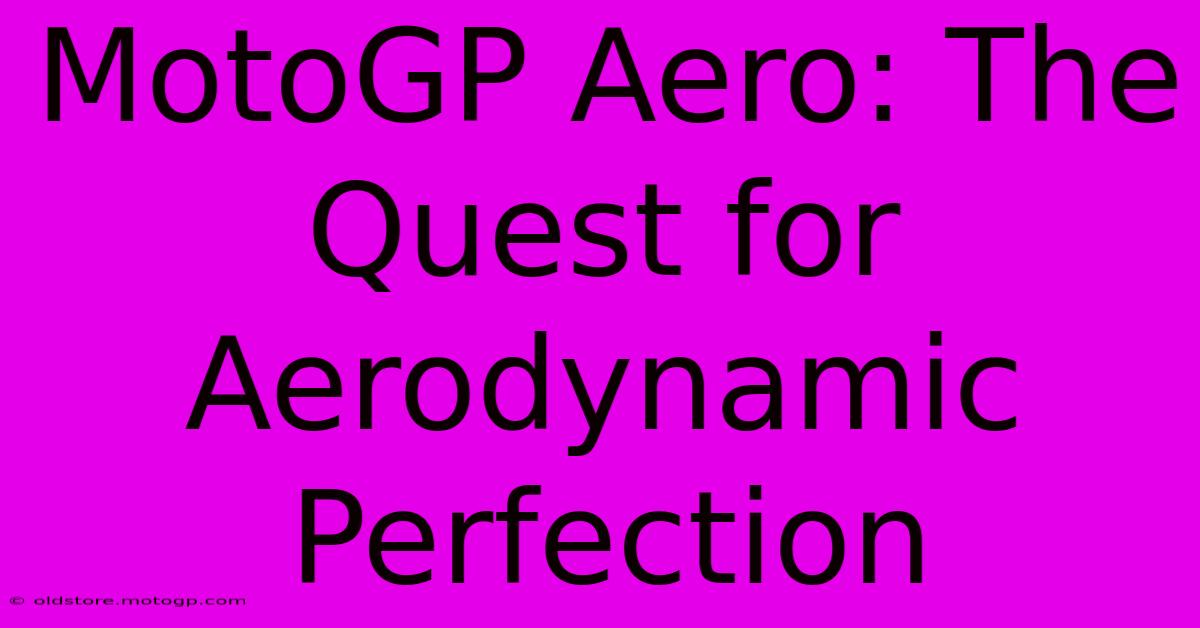MotoGP Aero: The Quest For Aerodynamic Perfection

Table of Contents
MotoGP Aero: The Quest for Aerodynamic Perfection
MotoGP racing is a relentless pursuit of speed, and a significant battleground in this pursuit is aerodynamics. Every millisecond shaved off lap times can mean the difference between victory and defeat, making aerodynamic advancements a critical area of focus for all teams. This article delves into the fascinating world of MotoGP aero, exploring the science, the technology, and the ongoing quest for aerodynamic perfection.
The Science of Speed: Understanding MotoGP Aerodynamics
Aerodynamics in MotoGP is a complex interplay of forces. The primary goal is to maximize downforce while minimizing drag. Downforce, the force pushing the bike towards the track, increases grip, allowing for faster cornering speeds and more stable braking. Drag, on the other hand, resists forward motion, slowing the bike down. The ideal balance is crucial – enough downforce for optimal handling without excessive drag that saps speed on the straights.
Key Aerodynamic Components:
- Fairings: The motorcycle's bodywork, meticulously sculpted to manage airflow. Every curve and surface is designed to minimize drag and generate downforce. Even seemingly small changes can have a significant impact.
- Wings: These prominent appendages, often located on the front and rear of the bike, generate significant downforce. Their design is constantly evolving, with teams experimenting with different shapes, sizes, and configurations.
- Winglets: Smaller wings or aerodynamic elements that fine-tune airflow around specific areas of the bike. These can be found in various locations, contributing to overall aerodynamic performance.
- Underbody Aerodynamics: This often-overlooked area plays a crucial role. Smooth underbody surfaces minimize drag, while strategically placed elements can generate downforce.
Technological Advancements: Pushing the Boundaries
The quest for aerodynamic perfection drives constant innovation in MotoGP. Teams employ sophisticated Computational Fluid Dynamics (CFD) simulations to model airflow and optimize designs before physical testing. Wind tunnels provide crucial real-world testing, allowing engineers to fine-tune designs and evaluate performance under controlled conditions. The use of advanced materials, like lightweight carbon fiber, is essential for reducing weight while maintaining structural integrity.
The Ever-Evolving Landscape:
The development of MotoGP aero is a continuous process. New regulations, rival teams' innovations, and the ongoing quest for marginal gains fuel a relentless cycle of research, development, and testing. What works today might be obsolete tomorrow, prompting engineers to constantly push the boundaries of what's possible.
The Impact of Aerodynamics on Riding Style and Race Strategy
Aerodynamic performance significantly impacts a rider's style and race strategy. High downforce allows riders to carry more speed through corners, enabling later braking and faster corner exits. However, excessive downforce can create instability at high speeds, demanding precise control from the rider. Teams must carefully balance aerodynamic performance with rider comfort and ability.
Strategic Considerations:
Aerodynamic setup can be tailored to specific tracks. Tracks with numerous high-speed corners might benefit from increased downforce, while those with long straights might prioritize reduced drag. Teams meticulously analyze track data and rider feedback to optimize their aerodynamic configurations for each race weekend.
The Future of MotoGP Aero: What Lies Ahead?
The future of MotoGP aerodynamics promises further advancements. The use of Artificial Intelligence (AI) in design optimization is expected to play an increasingly important role. AI algorithms can analyze vast amounts of data to identify optimal aerodynamic configurations, potentially leading to breakthroughs in performance. Further refinement of existing technologies and the exploration of novel aerodynamic concepts will continue to shape the sport.
In conclusion, the pursuit of aerodynamic perfection is a central theme in MotoGP. The constant push for marginal gains, coupled with technological advancements, ensures that the science of aerodynamics will continue to play a pivotal role in determining race outcomes and shaping the future of the sport. The quest for speed is ultimately a quest for aerodynamic dominance.

Thank you for visiting our website wich cover about MotoGP Aero: The Quest For Aerodynamic Perfection. We hope the information provided has been useful to you. Feel free to contact us if you have any questions or need further assistance. See you next time and dont miss to bookmark.
Featured Posts
-
Feel The Force F1 Concert Is Coming To Town
Feb 22, 2025
-
Moto Gp Race Tracks A Bucket List For Motorsport Enthusiasts
Feb 22, 2025
-
Motorbike Racing Explained A Beginners Guide To Various Types
Feb 22, 2025
-
Lot R The Cota Parking Key
Feb 22, 2025
-
Cota One Day Pass Experience Columbus To The Fullest
Feb 22, 2025
